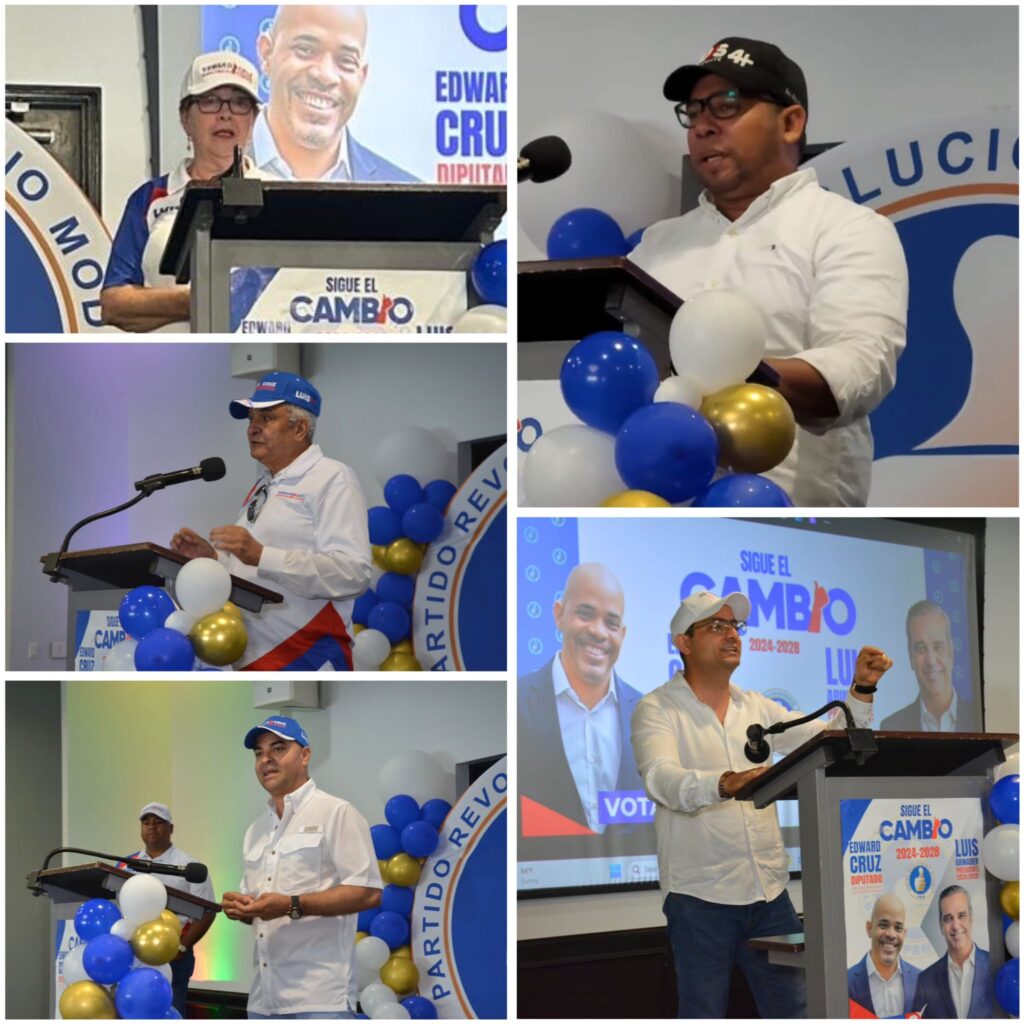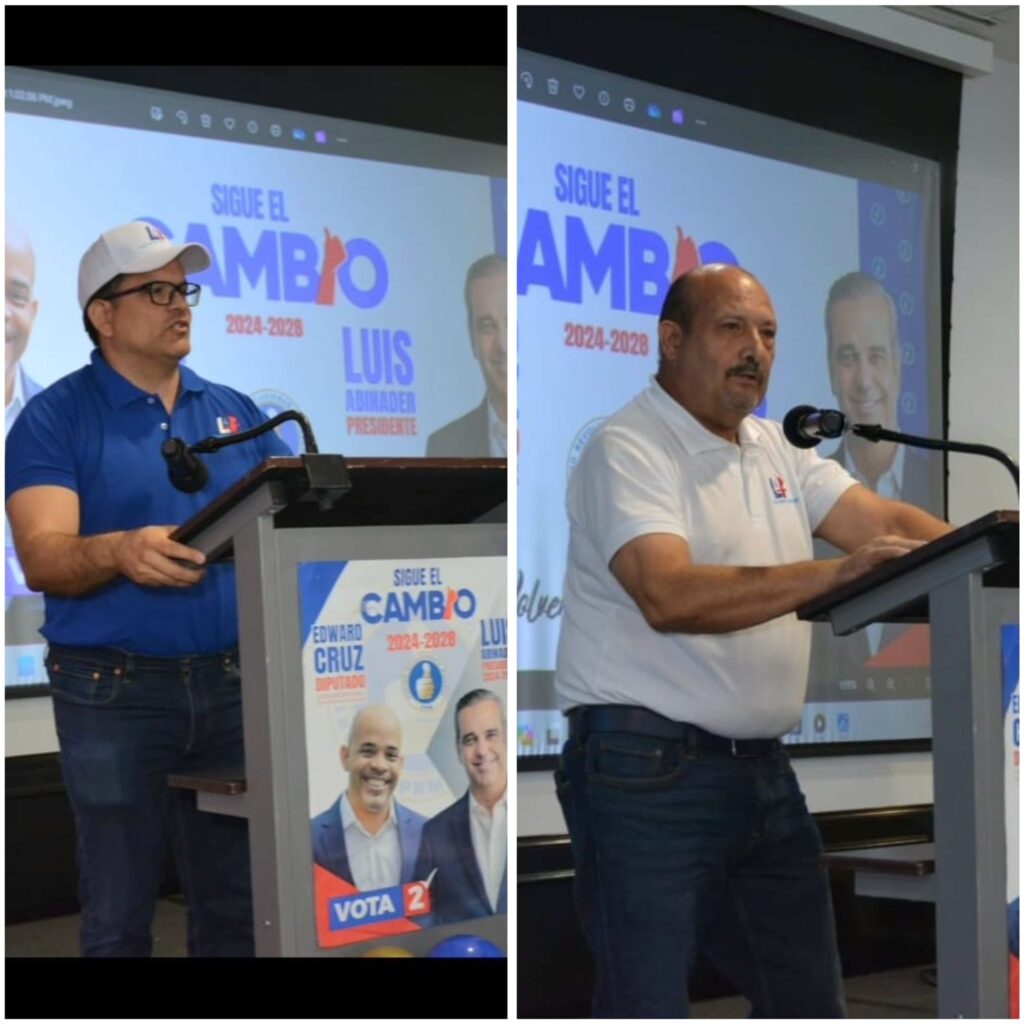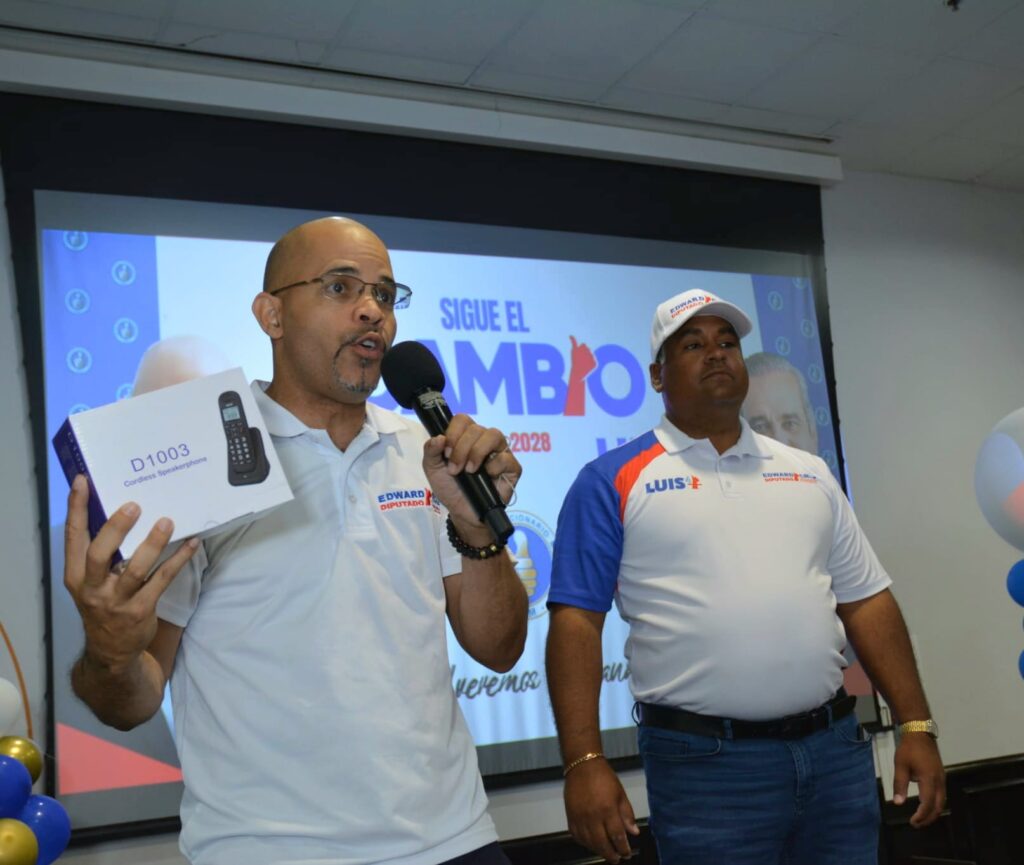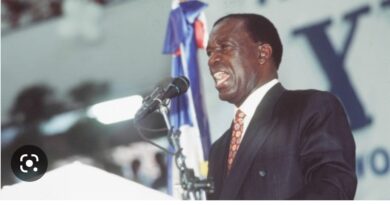Edward Cruz, candidato a diputado del PRM por la circunscripción II del exterior encabezó su cierre de campaña en Miami
Por Norberto Martínez
DIARIO ULTRAMAR, MIAMI, Florida.- El candidato a diputado del PRM por la circunscripción II del exterior, Edward Cruz, encabezó su cierre de campaña.

El evento lo condujo como maestro de ceremonias el coordinador general de campaña del candidato a diputado Francis Martínez, la co-coordinadora del Comando de Mujeres Revolucionarias Modernas, Milagros Brooks, a través de una oración invocó la presencia del Señor y bendijo el acto.

Los dirigentes políticos de la Seccional Florida Sur del PRM, Ángel Aguasvivas, Jhoan Gómez, Kelvin Acosta, Juan B. Medina y Nancy González, en sus ponencias se exhibió que estuvieron cargadas de mucha sensibilidad humana, transmitiendo la mas alta y profunda solidaridad al «Proyecto Político Edward Cruz Diputado», posteriormente les hicieron un llamado a los dominicanos residentes en el exterior, a votar este 19 de mayo por Luis Abinader como presidente y Edward Cruz como diputado, para que el cambio siga a partir del 16 de agosto.

El secretario general y presidente de la Seccional Florida Sur del PRM, Luis Lasosé y Richard Montilla, respectivamente, hicieron uso de la palabra y de forma institucional dijeron sentirse muy complacidos por el respaldo que le vienen brindando al presidente Luis Abinader, para que siga gobernando la República Dominicana, además puntualizaron estar convencidos que 19 de mayo allí ganará Abinader como presidente, Edward Cruz y Adelys Olivares como diputados de la circunscripción II, debido a que el PRM va a ganar las elecciones con más del 70%.

El discurso central del acto estuvo a cargo del candidato a diputado del PRM por la circunscripción II del exterior, Edward Cruz, quien felicitó y abrazó a las madres presentes en su Día, en especial a la suya Milagros Brooks y su esposa Gilma Cruz, le expresó su gratitud y felicitación a su padre Juan Cruz, quien estaba de fiesta de cumpleaños.
Le agradeció públicamente su respaldo a su gran equipo de campaña del sur de la Florida, el cual está conformado por: Francis Martínez, Kelvin Acosta, Ángel Aguasvivas, Orquídea Olivo, Nancy González, Norberto Martínez, Juan B. Medina, Rafael Valdez padre, Rafael Valdez Jr., Ramón Marmolejos, Rosa Espinal, Pedrito Ozuna, Johnny Encarnación, Joselina Cuevas, Carolina Espinal, Ney Lapaix, José Alberto Matías, Fernand Delgado, Florentino Ureña, entre otros que allí no se encontraban presentes.
Edward expresó: «Con el favor de Dios, el respaldo que ustedes nos vienen brindando y las demás demarcaciones vamos a salir electo como diputado, para poder representarlos dignamente en cada una de nuestras acciones legislativas, como dirigente político y comunitario que nos duele la comunidad del exterior, y eso no se negocia, debido a que estamos más que comprometidos».
Enfatizó: «Hemos sido víctima de una voraz campaña sucia para desenfocarnos, pero no lo han logrado, porque Dios guía nuestros pasos y sabe que desde una cural tendremos muchas oportunidades para contribuir con el desarrollo y bienestar de la comunidad dominicana en el exterior».
Subrayó: «En la política soñar no cuesta nada, pero cuando tú a ese sueño le sumas el accionar, el trabajo, el trabajar por ese sueño, los frutos positivos se ven».
Consideró: «Que la política para aquellos que la ejercemos de corazón del punto de vista económico atrasa, es la realidad atrasa. Nosotros pasamos de ser presidente de la Juventud a presidente de la Seccional Florida Sur y con Dios delante vamos a resultar electo como diputado, porque creemos en el trabajo tesorero en equipo y en el espíritu de la solidaridad para con nuestros conciudadanos».
Señaló: «Yo he visitado 23 países y así como tenemos compromisos aquí, también tenemos compromisos con cada uno de ellos, yo no les puedo quedar mal, yo no puedo pensar solo en mi, porque yo me debo a ustedes».
Añadió: «Yo me siento orgulloso de trabajar con gentes como ustedes que tienen capacidad política, repito capacidad política de entender que la palabra cambio no es un mote, sino una forma de pensar, nosotros debemos comprender que ser revolucionarios y modernos van de la mano, porque revolucionario significa ser innovador, cambiante, que tú no tienes miedo a ser decido, creer en tu verdad y profundas convicciones, pero también conlleva a que te llamen hasta intransigente, pero todo lo que hacemos va en favor y defensa de nuestra comunidad dominicana en el exterior».
En la parte final apunto: «Yo vine aquí a trabajar por un cambio, cuando fuimos junto con un equipo a la República Dominicana y le dijimos al aspirantere a la candidatura presidencial Luis Abinader, nosotros le vamos a coordinar su campaña en el estado de la Florida y después que nos designaron ganamos en las internas, en las elecciones del 2016 y en el 2020 con un 74% aproximadamente, porque creímos y creemos en el discurso de Abinader, el cual ha cumplido todas sus promesas de campaña, por eso este 19 de mayo a votar por Luis Abinader como presidente y Edward Cruz como tu diputado».

Con motivo del Día de las Madres que se celebra en los Estados Unidos, el candidato a diputado Edward Cruz, realizó entrega de regalos para halagar a las mamás dominicanas que comparecieron al acto de cierre de campaña.







Tribpub.info 최대 10배 레버리지를 제공하며 더 강력한 보안 프로토콜을 사용하기 때문에 기존의 불안한 레버리지 시장과 차별화는 물론, 더 나은 환경을 회원들에게 제공하고 있습니다.
Puncak88 adalah website penyedia layanan game slot gacor dengan menawarkan winrate kemenangan mencapi 99%, segera daftar dan menangkan jepe setiap hari bersama puncak88.
I think this is one of the such a lot significant info for
me. And i’m happy reading your article. However should statement on some normal things, The site style is great, the articles is really great : D.
Just right activity, cheers
I constantly emailed this weblog post page to all my friends,
because if like to read it next my links will too.
I like the valuable information you provide in your articles.
I’ll bookmark your weblog and check again here regularly.
I am quite certain I will learn many new stuff right here!
Best of luck for the next!
Thanks for sharing your info. I really appreciate your efforts
and I am waiting for your further post thanks once again.
I will right away grab your rss feed as I can’t to find
your e-mail subscription link or newsletter service.
Do you’ve any? Kindly permit me recognise in order that I could subscribe.
Thanks.
This is very fascinating, You’re an excessively professional blogger.
I have joined your feed and look forward to looking for more of your wonderful post.
Also, I’ve shared your website in my social networks
Pretty component of content. I just stumbled upon your
site and in accession capital to claim that I get in fact enjoyed account your
weblog posts. Anyway I’ll be subscribing in your augment or even I fulfillment you get right of
entry to consistently fast.
I’m not sure exactly why but this site is loading extremely slow for me.
Is anyone else having this issue or is it a problem on my end?
I’ll check back later and see if the problem
still exists.
It’s a pity you don’t have a donate button! I’d certainly donate to this fantastic blog!
I guess for now i’ll settle for book-marking and adding your RSS feed to
my Google account. I look forward to fresh updates and will share this website
with my Facebook group. Talk soon!
## Understanding the Significance of Link Building
Link building entails acquiring links from other websites to your own. These
hyperlinks are seen as approvals of credibility by Google.
The more reputable hyperlinks you possess, the better your website’s likelihood of
showing up better on search results.
## Categories of Backlinks
### Natural Links
Organic links are acquired without requiring actions from the website owner.
These links occur when other webmasters find your articles valuable and cite
it.
### Manual Links
Solicited links include proactively requesting links from other websites.
This can include reaching out to website owners, requesting links to your articles.
### Self-Made Links
User-Generated links are built by inserting your site’s link to blog comments.
Even though these links can offer a fast improvement, they
usually come with limited value and can lead to punishments from
Bing.
## Successful Link Building Strategies
### Content Creation & Promotion
Creating high-quality posts that automatically gains links is a basic method for
efficient link building. Listed below are some tips:
– Create high-quality articles that answer frequent problems in your niche.
– Develop infographics that display intricate information in an digestible way.
– Produce comprehensive guides on areas that are valuable to your
visitors.
### Guest Articles
Guest articles is a further efficient method to build valuable hyperlinks.
This involves creating articles for other websites in your field.
Ensure that your guest blogs are high value and include a link
to your page.
### Broken Link Repairing
Broken link repairing is a technique that entails locating broken links on other sites
and recommending your site as a alternative.
This not only aids the webmaster correct their broken link but also
gives you a valuable link.
### Outreach and Collaboration
Building networks with other site owners in your field
is a long-term strategy for link building.
Here are some methods to consider:
– Participate in discussion boards pertaining to your industry.
– Distribute other people’s content and give useful feedback.
– Partner on shared projects such as research studies.
### Social Media
Distributing your articles on social networks can enhance its reach and chance to
acquire backlinks. Engage with your audience on networks like Facebook and Instagram to develop a strong online presence.
## Measuring the Effectiveness of Your Link Building Strategy
### Applications for Link Analysis
Numerous applications are available to help you measure
the effectiveness of your link building campaign. Some commonly used software are:
– Google Analytics
– Ahrefs
– Moz Pro
– SEMrush’s Backlink Audit
– Majestic’s Tools
### Measures to Follow
When evaluating the effectiveness of your link building
efforts, consider the upcoming indicators:
– Domain Rating
– Page Rating
– Quantity of referring domains
– Quality of links
– Visitors referred by links
### Adjusting Your Plan
Depending on the data obtained from your analysis, tweak your
link building strategy to improve its success. It might entail focusing on various categories of posts, targeting different platforms, or refining your outreach method.
## Common Errors in Link Building and How to Prevent Them
### Poor Links
One of the frequent mistakes is get poor links from non-relevant or dubious sites.
These backlinks can harm your webpage’s search engine ranking.
### Excessive Optimization
Employing keyword-rich anchor text too often can cause punishments from search engines.
Strive for a balanced blend of link text.
### Overlooking Nofollow Links
Even though nofollow links don’t transfer SEO juice, they
might nevertheless generate hits and enhance brand
awareness.
## Upcoming Trends in Link Building
### Artificial Intelligence and Hyperlink Strategy
As the advancement of machine learning, link building
strategies are getting more sophisticated. Artificial intelligence applications can assist in finding relevant hyperlink prospects and anticipating their effect on site authority.
### Voice Queries and Link Building
The growth of voice queries is altering the way content is accessed.
This will affect backlink acquisition by altering the focus to spoken phrases and long-tail
keywords.
## Summary
Successful link building is a crucial aspect of search engine optimization. By comprehending the value of high-quality
links, using diverse strategies, and continuously monitoring your campaigns, you are able to enhance your webpage’s
ranking and attain greater rankings on Bing.
By keeping updated with the latest developments and avoiding frequent pitfalls,
you will navigate the ever-changing world of website optimization and achieve long-term results.
## Grasping the Importance of Link Building
Link building entails obtaining hyperlinks from other
webpages to your own. Such hyperlinks are considered
endorsements of confidence by Bing. The more high-quality hyperlinks you get,
the higher your webpage’s likelihood of ranking better on search engine results pages.
## Kinds of Backlinks
### Organic Links
Organic links are obtained without any actions from the webmaster.
These links occur when other sites discover your
content valuable and link to it.
### Outreach Links
Outreach links include deliberately requesting links from other websites.
This can involve emailing bloggers, soliciting hyperlinks to your articles.
### Self-Made Links
Self-Made links are built by placing your site’s link to forums.
Even though these links might offer a quick boost, they usually have low authority and can cause penalties from
search engines.
## Successful Link Building Techniques
### Content Creation & Marketing
Creating high-quality posts that organically earns links is a core method
for effective link building. Listed below are some advice:
– Write valuable blog posts that answer frequent questions
in your field.
– Develop infographics that show intricate information in an simple
format.
– Produce comprehensive tutorials on subjects that are
thought to be important to your audience.
### Guest Posting
Guest posting is an additional effective method to build authoritative
links. This involves writing articles for other blogs in your industry.
Make sure that your guest posts maintain high value and
include a hyperlink to your site.
### Broken Link Fixing
Broken link building is a method that entails finding broken links
on other sites and recommending your content
as a replacement. This not only assists the webmaster correct their broken link but also provides you
a valuable backlink.
### Contact and Networking
Building connections with other site owners in your industry is
a long-term strategy for acquiring backlinks. Below are some methods to consider:
– Participate in discussion boards pertaining to your industry.
– Share other users’ articles and offer useful input.
– Work together on collaborative projects such as ebooks.
### Social Networks
Distributing your articles on social networks can boost its visibility and potential to acquire links.
Interact with your community on platforms like Twitter and Instagram to build a robust online presence.
## Assessing the Effectiveness of Your Link Building Campaign
### Software for Link Analysis
Several tools are available to help you assess the
effectiveness of your link building strategy. Some well-known software are:
– GA
– Ahrefs’ SEO Tools
– Moz Pro
– SEMrush’s Tools
– Majestic
### Indicators to Track
When measuring the effectiveness of your link building efforts, look at the upcoming indicators:
– Domain Rating
– Page Authority
– Number of referring domains
– Authority of backlinks
– Visitors referred by backlinks
### Adjusting Your Strategy
Based on the data gathered from your analysis, tweak your link building plan to boost its
effectiveness. It might involve emphasizing other kinds of posts,
aiming at new platforms, or updating your outreach strategy.
## Frequent Mistakes in Link Building and How to Overcome Them
### Poor Links
One of the frequent pitfalls is obtaining bad links from irrelevant or
low-authority websites. These backlinks might hurt your website’s search engine ranking.
### Too Much Optimization
Employing keyword-rich anchor text frequently can result in sanctions from Google.
Aim for a natural blend of link text.
### Ignoring Nofollow Attributes
While nofollow links aren’t transfer ranking authority,
they might nonetheless drive hits and build visibility.
## Emerging Changes in Link Building
### Machine Learning and Hyperlink Strategy
With the evolution of artificial intelligence, link building methods are turning more
complex. Artificial intelligence software can help in discovering relevant link opportunities and forecasting the potential on site authority.
### Voice Queries and Link Building
The rise of voice queries will be changing the way content is retrieved.
This is expected to impact link building by shifting importance
to conversational queries and specific queries.
## Final Thoughts
Efficient link building is a vital component of search engine optimization. By understanding the significance of reputable backlinks, using different
strategies, and continuously monitoring your efforts, you will improve your website’s authority and achieve higher results on Google.
By remaining current with the latest changes and overcoming typical mistakes,
you can navigate the dynamic realm of SEO and attain sustainable success.
If you want to get much from this post then you have to apply these methods to
your won web site.
Promoting via social networks is now an essential aspect of every business strategy.
In the current digital age, neglecting the impact of networks such as Instagram, Facebook, Twitter, and Pinterest.
These social networks offer unique avenues to engage with a global audience.
1. Creating a Robust Profile
To succeed in social media marketing, companies should primarily build a strong
profile on their selected platforms. This includes setting
up high-quality pages that highlight the brand’s
identity and goals.
Consistent branding, including graphics, color schemes, and voice, is
key. It helps in creating familiarity and credibility among fans.
2. Content is King
Developing engaging posts is the core of social media marketing.
The content must be related to the audience’s interests and provide benefit.
This might involve informative articles, entertaining videos,
and compelling photos. Regular updates maintains the followers interested and drives interaction.
3. Leveraging Influencers
Influencer marketing has gained significant traction in recent years.
Content creators enjoy engaged fans that trust their recommendations.
By teaming up with suitable influencers, businesses can reach new followers and improve their reputation.
It’s essential to pick influencers who align with the company’s mission and demographic.
4. Harnessing Data
Social media platforms give a wealth of information that can be
harnessed to refine marketing strategies.
Reviewing engagement rates, number of views, and conversion rates enables companies to understand
what is effective and what doesn’t.
These metrics can inform future content creation, guaranteeing efforts are better
focused and effective.
5. Utilizing Paid Promotions
Although unpaid reach is important, utilizing paid ads can greatly increase reach on social media.
Platforms like Facebook, Instagram, and LinkedIn provide
multiple advertising options that fit different budgets and targets.
These ads can be targeted considering demographics, places,
and user behavior, guaranteeing they impact the intended viewers.
6. Engaging with the Audience
Engagement is essential to building a loyal community on social media.
Responding to comments, thanking retweets, and engaging in discussions helps create solid bonds
with followers.
This makes more relatable the brand and promotes an atmosphere of belonging, resulting in stronger brand advocacy.
Conclusion
Social media marketing is a dynamic effort that needs consistency,
creativity, and careful thought. By prioritizing establishing a
strong presence, producing engaging content, partnering with content creators, monitoring performance, investing in paid ads, and fostering community,
companies can attain remarkable results in the dynamic world
of social media marketing.
Social media marketing is becoming an essential aspect of all business
strategy. In the current internet era, neglecting
the power of platforms like Instagram, Facebook,
Twitter, and TikTok. These online sites offer unique chances to engage with millions
of users worldwide.
1. Building a Solid Foundation
To excel in social media marketing, organizations
should primarily build a strong profile on their chosen platforms.
This involves setting up professional accounts that
highlight the company’s values and purpose.
Uniform branding, such as icons, color palettes, and tone, is crucial.
It aids in building recognition and reliability among fans.
2. Engaging Content Creation
Developing valuable posts is the core of social media marketing.
Posts need to be relevant to the followers’ needs and give benefit.
This could encompass how-to guides, entertaining videos, and eye-catching images.
Regular updates ensures the followers interested and promotes participation.
3. Leveraging Influencers
Influencer marketing has attained significant popularity in recent years.
Key opinion leaders enjoy engaged fans that rely on their suggestions.
Through collaboration with appropriate influencers,
businesses can tap into new markets and enhance their trustworthiness.
It’s important to select influencers who match the brand’s values and target
audience.
4. Harnessing Data
Social media platforms give a wealth of data that
can be leveraged to refine marketing strategies.
Examining user data, number of views, and conversion rates allows organizations to grasp what is effective and what doesn’t.
This data can guide future content creation, making sure initiatives are strategically aligned
and effective.
5. Utilizing Paid Promotions
Despite free engagement is valuable, investing in paid advertising can significantly enhance exposure on social media.
Networks such as Facebook, Instagram, and LinkedIn offer multiple ad formats that fit various financial plans
and goals.
These ads can be targeted based on demographics, places, and activity patterns,
ensuring they impact the intended viewers.
6. Building Relationships
Interaction is crucial to building a loyal following on social media.
Interacting with messages, thanking retweets, and joining dialogues contributes to create solid connections with fans.
This humanizes the brand and promotes a
sense of belonging, resulting in increased retention.
Wrapping Up
Marketing through social networks is a dynamic journey that demands commitment, originality, and
careful thought. By prioritizing establishing a strong presence, creating
high-quality material, leveraging influencers, utilizing analytics, investing in paid ads, and fostering
community, businesses can reach significant success
in the dynamic world of social media marketing.
Way cool! Some extremely valid points! I appreciate you writing this article and also the rest of the website is also very good.
Heya i’m for the first time here. I came across this board and I to find It really
useful & it helped me out a lot. I hope to offer something again and
help others such as you aided me.
It’s awesome how wonderfull this site is Get more info
It’s awesome how wonderfull this site is
Music sheets and scores serve as the guide for musicians.
Music scores and scores serve to translate musical ideas into a translatable format.
Elements of Music Sheets and Scores
1. **Staff:** A framework of lines and spaces used to notate musical pitches.
2. **Symbols:** Symbols used to denote the pitch range of the notes.
3. **Tones:** The symbols used to indicate the pitch and duration of
sounds in music.
4. **Rests:** Symbols used to indicate moments
of silence in a piece.
5. **Rhythm:** Denotes the rhythmic structure of the composition.
6. **Scale:** Indicates the key of the music
by specifying which notes are sharp or flat.
7. **Intensity:** Indications of the volume of the music.
8. **Articulation:** Instructions on how to perform each note or phrase.
9. **Pace:** The speed at which the piece should be performed.
10. **Ornaments:** Indications of additional notes for expressive
effect.
Reading Music Sheets and Scores
Comprehending music sheets and scores necessitates knowledge of the various parts and symbols
used.
Benefits of Learning to Read Music Sheets and Scores
1. **Improved Knowledge:** Learning to read music provides a deeper comprehension of
musical structure.
2. **Greater Flexibility:** Greater flexibility in playing different genres and
styles is achieved by reading music.
3. **Improved Interaction:** Musicians who read music can collaborate more effectively.
4. **Preservation of Music:** Archiving music in written form helps maintain its historical record.
5. **Personal Fulfillment:** Learning to read music can be a
deeply fulfilling and rewarding experience.
Tips for Beginners
1. **Keep it Basic:** Begin with simple pieces and gradually
move to more complex ones.
2. **Consistent Practice:** Frequent practice is key to mastering music reading.
3. **Take Advantage of Tools:** Many resources are available online to help beginners learn to read music.
4. **Seek Support:** Seek support from others who
are also learning to read music.
5. **Stay Persistent:** Stay persistent and don’t get discouraged by challenges.
Advanced Techniques
1. **On-the-Spot Playing:** On-the-spot playing of music from written notation.
2. **Changing Keys:** The process of changing the key
of a piece of music.
3. **Building Chords:** The practice of adding harmonies to a melody.
4. **Ad-Libbing:** Spontaneous composition of music on the spot.
5. **Expressive Playing:** Adding personal expression to the performance of written music.
Famous Composers and Their Scores
1. **L. Beethoven:** Renowned for his profound and expressive music.
2. **Wolfgang Amadeus Mozart:** Known for his intricate and beautifully structured compositions.
3. **Bach:** Known for his masterful use of counterpoint and harmony.
4. **P. I. Tchaikovsky:** Famous for his richly orchestrated and emotive music.
5. **Debussy:** Renowned for his innovative use of harmony and texture.
Digital vs. Traditional Music Scores
**Advantages of Digital Scores:**
– Accessibility: Easily accessible on various devices.
– Editing: Simple to make changes and adjustments.
– Capacity: Easy to store and organize.
**Benefits of Paper Music:**
– Hands-On: Engaging tactile experience.
– Longevity: Stands the test of time.
– Artistic Value: Aesthetic and artistic value.
The Role of Technology in Music Scores
Technology has changed the way we interact with music scores.
**Digital Sheet Music Apps:** Digital sheet music apps provide convenient platforms for composing and distributing music.
**Online Libraries:** Online libraries provide access to a wide range
of music scores.
**Interactive Learning Tools:** Technology-based tools provide interactive music learning opportunities.
Conclusion
Music sheets and scores play a crucial role to the craft of music.
Whether you just started or are experienced, comprehending how to read and work with music sheets and scores is
valuable.
Embrace the path of understanding music sheets and scores,
and discover the creative opportunities that lie ahead.
The history of music sheets is a deep tapestry that
spans across ages.
Early Beginnings
The earliest versions of music notation trace back to ancient civilizations.
Ancient Mesopotamians designed simple music notation techniques to preserve their rituals.
The Greek Contribution
Greek society made important contributions to music notation.
Medieval Innovations
The medieval period experienced major advances in music notation.
The Renaissance Era
Renaissance period brought a renewal of music,
including music notation.
Baroque and Classical Periods
During the Baroque and Classical periods, music notation evolved further, becoming more sophisticated.
The Romantic Era
The Romantic age brought about novel emotional methods in music notation.
The Modern Age
In the modern era, music notation saw major changes, integrating technology.
The Digital Revolution
The introduction of computer-based scores transformed the field of music notation.
Key Milestones in Music Notation History
1. **Primitive Symbols:** Early Egyptian hieroglyphs
used to depict music.
2. **Medieval Notation:** Development of staff lines and notation methods in medieval Europe.
3. **Classical Evolution:** Advancements in notational precision during the Renaissance.
4. **19th Century:** 19th-century innovations in music notation techniques.
5. **20th Century:** Introduction of graphic scores and experimental notation in the
20th century.
The Role of Music Sheets in Education
Music sheets act as a vital role in music pedagogy.
Notable Composers and Their Contributions
1. **Johann Sebastian Bach:** Renowned for his elaborate and accurate notation techniques.
2. **Ludwig van Beethoven:** Advanced the use of
expressive dynamics in notation.
3. **W.A. Mozart:** Excelled in the Classical era’s precise and clear notation.
4. **Frédéric Chopin:** Expanded the use of expressive notations for piano music.
5. **Igor Stravinsky:** Revolutionized 20th-century notation with his complex scores.
Evolution of Music Sheets in the Digital Age
The modern era has significantly altered the method we create music sheets.
Future of Music Sheets
The next era of music sheets holds intriguing developments.
With the evolution of technology, the techniques composers use to
compose and publish music sheets will in parallel evolve.
Conclusion
The story of music sheets is rich, mirroring the advancement of music itself.
From ancient symbols to modern notations, music sheets have served
as a crucial tool for documenting and transmitting compositions.
As we progress, the legacy of music sheets will continue,
changing with future advancements.}
Music sheets have a long history that extends over ages.
Early Beginnings
The initial versions of music notation date back to prehistoric
times.
Ancient Egyptians designed rudimentary music notation methods to document their musical practices.
The Greek Contribution
The Greeks made notable contributions to music notation.
Medieval Innovations
The medieval period witnessed major progress
in music notation.
The Renaissance Era
Renaissance period brought a rebirth of art, including music notation.
Baroque and Classical Periods
During the Baroque and Classical periods, music notation evolved further,
becoming more complex.
The Romantic Era
The Romantic age brought about innovative emotional techniques in music notation.
The Modern Age
In the contemporary period, music notation experienced significant
changes, incorporating technology.
The Digital Revolution
The introduction of digital music changed the landscape
of music notation.
Key Milestones in Music Notation History
1. **Primitive Symbols:** Early Egyptian hieroglyphs used to depict music.
2. **Guido d’Arezzo:** Guido d’Arezzo’s revolutionary contributions to music notation.
3. **Baroque Notation:** Advancements in notational precision during the Renaissance.
4. **Expressive Notation:** Increased complexity and detail in Romantic music notation.
5. **20th Century:** Revolutionary changes in music notation practices in the modern age.
The Role of Music Sheets in Education
Music sheets act as a vital part in music education.
Notable Composers and Their Contributions
1. **Bach:** Renowned for his elaborate and accurate notation techniques.
2. **L. Beethoven:** Pioneered expressive notations
and dynamic markings.
3. **Mozart:** Excelled in the Classical era’s precise and clear notation.
4. **F. Chopin:** Known for his detailed and expressive piano music notations.
5. **Stravinsky:** Pioneered 20th-century notational innovations.
Evolution of Music Sheets in the Digital Age
The digital age has profoundly changed the way we create music sheets.
Future of Music Sheets
The coming age of music sheets holds exciting
advancements.
As technology evolves, the techniques artists use to compose and share music sheets will
in parallel progress.
Conclusion
The story of music sheets is intricate, mirroring the progress of music itself.
From primitive notations to modern notations, music sheets
have functioned as a crucial medium for recording and sharing musical
ideas.
As we look ahead, the history of music sheets will persist,
evolving with technological progress. }
Learning to read music sheets is crucial for every aspiring musician.
| Mastering how to read music sheets is vital for every novice musician. | Mastering the art of reading music sheets is
vital for any novice musicians.}
What Are Music Sheets?
Music sheets are written forms of music notation, indicating the tone as
well as rhythm of a musical composition.
Getting Started with Music Sheets
Learning reading music sheets begins with familiarizing yourself with the essential components
of music notation.
Understanding Musical Notation
Musical notation involves several key components, including notes, staff, rhythms, and clefs.
1. **The Staff**
The staff is truly an important element in musical notation.
In musical notation, this actually consists of five different lines and
also four different spaces.
2. **Clefs
Clefs denote which musical note corresponds to the five lines and spaces.
| Clefs denote what musical note is meant to these lines and the different spaces.
| Clefs is meant for the different lines as well as spaces.}
{There {are actually|actually are|is} {two|two separate|two
distinct} {primary|different|distinct} {clefs|clef|music notes} {used in|used in various|used in the} {music|musical} {notation|notes|notations}.
| There {are actually|actually are|is} {two|two separate|two distinct} {primary|different|distinct} {clefs|musical notes|clef} {used
in|used in various|used in the} {notations|music|musical}
{of|music} {these notes|these notes}.
Music sheets and scores work as the guide for musicians.
Music scores and scores serve to translate musical concepts into a readable
format.
Elements of Music Sheets and Scores
1. **Musical staff:** A framework of lines and spaces used to notate musical
pitches.
2. **Clefs:** Signs that designate the pitch range for notes on the staff.
3. **Tones:** Representations of musical sound with pitch and duration.
4. **Breaks:** Symbols used to indicate moments of silence
in a piece.
5. **Time Signature:** Shows the number of beats in each measure and the note value of each beat.
6. **Tonality:** Defines the tonality of the piece.
7. **Intensity:** Notations indicating the intensity of the
music.
8. **Expression:** Indicators of the expression or phrasing of notes.
9. **Pace:** The rate of the music’s execution.
10. **Ornaments:** Symbols showing extra notes
for decorative purposes.
Reading Music Sheets and Scores
Reading music sheets and scores demands understanding of the various elements and notations used.
Benefits of Learning to Read Music Sheets and Scores
1. **Improved Knowledge:** Reading music sheets
enhances one’s understanding of music theory and composition.
2. **Broader Skill Set:** Greater flexibility in playing
different genres and styles is achieved by reading music.
3. **Improved Interaction:** Improved interaction with other musicians is possible when reading music.
4. **Preservation of Music:** Documenting music
through scores ensures its longevity.
5. **Achievement:** Personal fulfillment is found in the ability to read
and interpret music.
Tips for Beginners
1. **Begin with Basics:** Start with the basics before tackling more
complex compositions.
2. **Frequent Practice:** Frequent practice is
key to mastering music reading.
3. **Use Resources:** Many resources are available online to help beginners learn to read music.
4. **Seek Support:** Joining a music community can provide support
and motivation.
5. **Stay Persistent:** Keep trying and don’t give up,
even when it gets tough.
Advanced Techniques
1. **Sight Reading:** Instant interpretation of music without needing to practice beforehand.
2. **Modulating:** The process of changing the key of a piece of music.
3. **Creating Harmonies:** Creating harmonies to complement a primary melody.
4. **Ad-Libbing:** Ad-libbing music as it is played.
5. **Personal Expression:** Playing written music with personal flair and expressiveness.
Famous Composers and Their Scores
1. **Ludwig van Beethoven:** Renowned for his profound and
expressive music.
2. **Wolfgang Amadeus Mozart:** Renowned for his musical brilliance and creativity.
3. **Bach:** Famous for his intricate and harmonically rich compositions.
4. **Pyotr Ilyich Tchaikovsky:** Known for his ability to convey
deep emotion through music.
5. **C. Debussy:** Known for his unique and expressive musical style.
Digital vs. Traditional Music Scores
**Pros of Digital Sheets:**
– Convenience: Available on multiple platforms.
– Alteration: Simple to make changes and adjustments.
– Capacity: Takes up less physical space.
**Advantages of Traditional Scores:**
– Tactile Experience: Engaging tactile experience.
– Resilience: Resilient and less prone to digital failures.
– Visual Beauty: Aesthetic and artistic value.
The Role of Technology in Music Scores
Technology has transformed the way we engage with
music scores.
**Digital Sheet Music Apps:** Apps designed for digital sheet music make it easier to compose, edit, and share
music scores.
**Online Libraries:** Platforms like IMSLP and Mutopia Project offer vast collections of free and
public domain sheet music.
**Interactive Learning Tools:** Tools like SmartMusic and Yousician offer interactive learning experiences
for musicians of all levels.
Conclusion
Music sheets and scores play a crucial role to the art of musicianship.
Whether you are new or an expert, comprehending how to read and interpret music sheets and scores is
essential.
Embrace the process of learning music sheets and scores,
and discover the endless possibilities that await.
Music sheets hold a fascinating history that extends across millennia.
Early Beginnings
The earliest versions of music notation trace back to ancient civilizations.
Ancient Egyptians designed basic music notation techniques
to record their melodies.
The Greek Contribution
Greek society made important advancements to music
notation.
Medieval Innovations
The Dark Ages experienced considerable progress in music notation.
The Renaissance Era
Renaissance brought a renewal of culture, including music notation.
Baroque and Classical Periods
During the Classical periods, music notation developed further, becoming more detailed.
The Romantic Era
The Romantic period brought about innovative expressive techniques in music notation.
The Modern Age
In the 20th century, music notation saw significant changes,
incorporating electronic systems.
The Digital Revolution
The arrival of electronic notation revolutionized the field of
music notation.
Key Milestones in Music Notation History
1. **Early Marks:** Ancient Greek symbols that represented musical concepts.
2. **Staff Lines:** Guido d’Arezzo’s revolutionary contributions to music notation.
3. **Baroque Notation:** Development of complex notational systems in the
Baroque period.
4. **Expressive Notation:** Incorporation of expressive dynamics and articulations in the Romantic era.
5. **Modern Notation:** Adoption of digital notation tools in contemporary music.
The Role of Music Sheets in Education
Music sheets play a important role in music education.
Notable Composers and Their Contributions
1. **Bach:** Renowned for his elaborate and accurate notation techniques.
2. **Beethoven:** Advanced the use of expressive dynamics in notation.
3. **W.A. Mozart:** Mastered the Classical style of clear and elegant notation.
4. **F. Chopin:** Expanded the use of expressive notations for piano
music.
5. **Stravinsky:** Pioneered 20th-century notational innovations.
Evolution of Music Sheets in the Digital Age
The contemporary period has profoundly changed the method we create music sheets.
Future of Music Sheets
The next era of music sheets foresees intriguing advancements.
As technology progresses, the methods artists use to produce
and distribute music sheets will likewise evolve.
Conclusion
The history of music sheets is intricate, reflecting the progress of music itself.
From primitive notations to electronic sheets, music sheets have been a
fundamental medium for preserving and sharing musical ideas.
As we move forward, the history of music sheets will persist, adapting with
technological progress. }
Music sheets represent a captivating history that stretches across millennia.
Early Beginnings
The first types of music notation go back to ancient civilizations.
Ancient Greeks developed rudimentary music notation techniques to preserve their musical practices.
The Greek Contribution
The Greeks made significant advancements to music
notation.
Medieval Innovations
The Dark Ages saw major advances in music notation.
The Renaissance Era
Renaissance period brought a resurgence of art, including music notation.
Baroque and Classical Periods
During the Baroque periods, music notation evolved
further, becoming increasingly sophisticated.
The Romantic Era
The Romantic age ushered in new dynamic styles in music notation.
The Modern Age
In the 20th century, music notation underwent significant changes, adopting digital tools.
The Digital Revolution
The arrival of digital music changed the domain of music notation.
Key Milestones in Music Notation History
1. **Primitive Symbols:** Early Egyptian hieroglyphs used to depict music.
2. **Staff Lines:** Development of staff lines and notation methods
in medieval Europe.
3. **Baroque Notation:** Advancements in notational precision during the Renaissance.
4. **19th Century:** 19th-century innovations in music notation techniques.
5. **20th Century:** Revolutionary changes in music notation practices in the modern age.
The Role of Music Sheets in Education
Music sheets serve a important part in learning music.
Notable Composers and Their Contributions
1. **Johann Sebastian Bach:** Famed for his intricate
and precise notation.
2. **Ludwig van Beethoven:** Innovated in the use of dynamic and expressive
notations.
3. **Mozart:** Perfected the Classical approach to elegant and clear notation.
4. **Chopin:** Expanded the use of expressive notations for piano music.
5. **Igor Stravinsky:** Known for his groundbreaking 20th-century notational techniques.
Evolution of Music Sheets in the Digital Age
The contemporary period has profoundly altered the method we create music sheets.
Future of Music Sheets
The coming age of music sheets foresees exciting advancements.
As technology proceeds to progress, so too will the techniques musicians use to compose and distribute music sheets.
Conclusion
The story of music sheets is rich, mirroring the evolution of
music itself.
From early marks to modern notations, music sheets
have served as a crucial tool for recording and sharing musical
ideas.
As we progress, the history of music sheets will continue,
evolving with each new era.}
Understanding music sheets is crucial for all beginning musician. | Learning how to read
music sheets is essential for every aspiring musician. | Mastering
the art of reading music sheets is crucial for any aspiring musicians.}
What Are Music Sheets?
Music sheets are written forms of music notes, showing the note as well as, pace of a musical composition.
Getting Started with Music Sheets
Grasping reading music sheets begins with familiarizing yourself with
the essential components of musical notation.
Understanding Musical Notation
Musical notation involves several crucial components, including clefs, notes, rhythms, and staff.
1. **The Staff**
The staff is an important element of musical notations.
The staff consists of five separate horizontal lines and four spaces.
2. **Clefs
This indicate which musical note is meant to the different
lines as well as, spaces. | Clefs indicate which note the actual note to these lines
and also these five spaces. | This clefs denote to
the different lines as well as the spaces.}
{There {are actually|actually are|is} {two|two separate|two distinct} {primary|different|distinct} {clefs|clef|music notes}
{used in|used in various|used in the} {music|musical} {notation|notes|notations}.
| There {are actually|actually are|is} {two|two separate|two
distinct} {primary|different|distinct} {clefs|musical notes|clef} {used in|used in various|used in the} {notations|music|musical} {of|music} {these notes|these notes}.